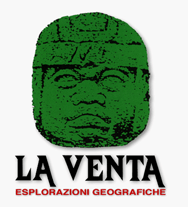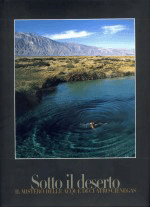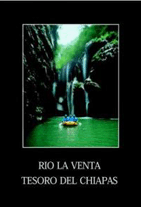Esplorazioni Geografiche La Venta

The La Venta Exploring Team conducts multidisciplinary research on caves and karst phenomena throughout the world, and serves as a voice and watchdog for the underground frontier through magazine articles, films, photographic exhibits, and illustrated books. Its primary explorations are focused on rare, remote caves formed under extreme and unusual environmental conditions-such as in quartz, lava, and deep inside the hearts of glaciers.
The exploration and research of unknown caves is a proud tradition in Italy, and Italian cavers are world-renowned for their skill and dedication in pushing their local caves to record depths. The fact that 40% of all explored caves in the world over 500m deep are in Italy and France is clear evidence of this.
In the early 1980s, Italian cavers began venturing further afield, exploring in remote countries like the Philippines, Mexico, and Pakistan. In 1989, this momentum reached a climax when a national project organized by Italy's most elite explorers to study karst phenomena in Uzbekistan ("Samarcanda 89") was finally realized in cooperation with Russian speleologists. On that expedition, explorers bottomed out beyond 1300m in Boy Bulok, the deepest cave known in Asia up to the year 2000.
Building on the success of the Samarcanda expedition, the La Venta Exploring Team was founded by part of this elite group in 1990 to study other unexplored karst areas around the world. The name 'La Venta' was chosen as both a symbol of accomplishment (it is the name of the Mexican canyon where the team's first official expedition took place and later on, theatre of the longest and most complex project ever carried out by the association), and of respect (it is also the name of the site where the mysterious Olmec heads are found in Mexico). With the passing of time the initial group has grown, adding Italian and foreign explorers to its former members.
During La Venta's first explorations to central Asia, southern Mexico, Brazil, and Patagonia, the Association set new standards in expedition caving by changing the focus from depth to diversity, and from record-seeking to research. Continuing in this tradition, La Venta expeditions today are based on an interdisciplinary scientific approach to exploration with the goal of finding geographically, ecologically, and socially important underground environments where they are most important to local cultures and most at risk.
The Association endeavors to expand the commonly-held concept of "caves" by discovering and studying karst phenomena in the earth's most remote and extreme environments - such as in lava, quartzite, and glaciers. The expeditions are based on the principle that underground exploration is much more than simply geographical mapping or ropework; it's a frontline survey of planet earth's modern day frontiers, the limits of human curiosity, and the potential of "speleological" conservation. By working with local communities and organizations, and producing books, films, and exhibits, the La Venta Exploring Team intends to serve as a voice for this new era of underground exploration and the long-term study and protection of earth's inner space.Here at the beginning of the third millennium, the total amount of cave passage that has so far been explored throughout the world amounts to barely fifteen-thousand kilometers, most of it surveyed in the past thirty years. In reality, the total amount of cave passage that exists under the earth is a thousand times that. We are at the beginning of the great age of underground exploration, and there are many frontiers left to explore.
This lack of knowledge about the underground world is also a call for conservation. Caves are fragile, endangered ecosystems with limited energy to recover from disturbance, yet they are vital to the health of our planet. In the years to come, the La Venta Exploring Team accepts the challenge of exploring and protecting this miraculous underground frontier. Through interdisciplinary research and documentation, we intend to increase humanity's awareness of caves as a fundamental part of any natural environment and every geographic endeavor.


Main Menu

Special cooperation and joint publications with Speleogenesis


